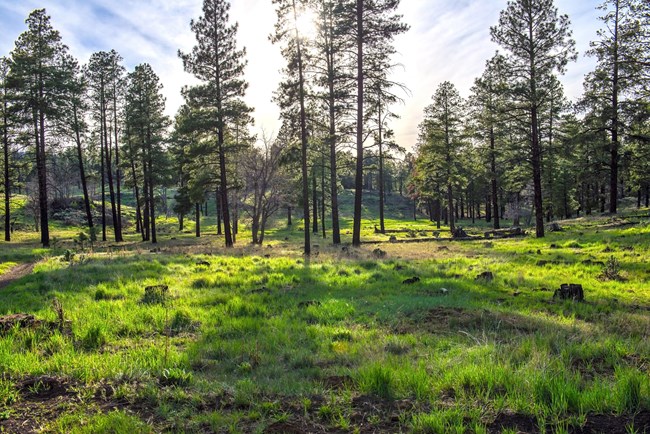
NPS/ T.Miller Little more than a hundred and fifty years ago, the ponderosa pine forest looked very different than it does today. Grand, yellow-barked pines towered over an understory rich with grasses, shrubs and wildflowers. Analysis of tree rings has shown that until 1863 low-intensity fires raced through every few summers. Small fires consumed the grasses and ladder fuels such as shrubs and small trees. The lack of ladder fuels protected old growth trees because the fuel load was insufficient to propel the fire into the forest canopy. As a result, ground fires helped maintain open, park-like stands. Land use practices of the nineteenth and twentieth centuries altered the forests. Logging removed large trees that were replaced over time by many smaller trees. Attempts to suppress fire allowed fuels that normally would have been removed on a regular basis to build up. The absence of fire has allowed tree density and fuel loads to increase from an average of 28 trees per acre in the late 1800s to more than 500 trees per acre today. The high fuel loads and increase in ladder fuels have changed the fire regime from high frequency/low intensity to one with a high likelihood of high intensity, catastrophic fire. Though ponderosa pines have thick bark for surviving low intensity ground fires, flames that reach the forest canopy can kill many trees. Forest communities are drastically altered, soil damaged, and human safety threatened. These stately woodlands provide almost as much to the ecosystem in life as they do in death. When a tree dies it often remains upright for many years. These old dead trees are called “snags”. Eventually, rot weakens them to the point of collapse. These old tree skeletons provide homes and roosts for a wide variety of birds and small mammals. Downy and hairy woodpeckers, northern flickers, and many other species of bird use cavities for building their nests. Even large birds like hawks, owls, and eagles use these trees for building nests or to roost and scan for food. Kaibab and rock squirrels also use these snags as places to live and hide their food. Insects also infest the dead wood and begin laying their eggs which hatch into grubs and become the primary prey for woodpeckers and other animals. |
Last updated: January 9, 2020
